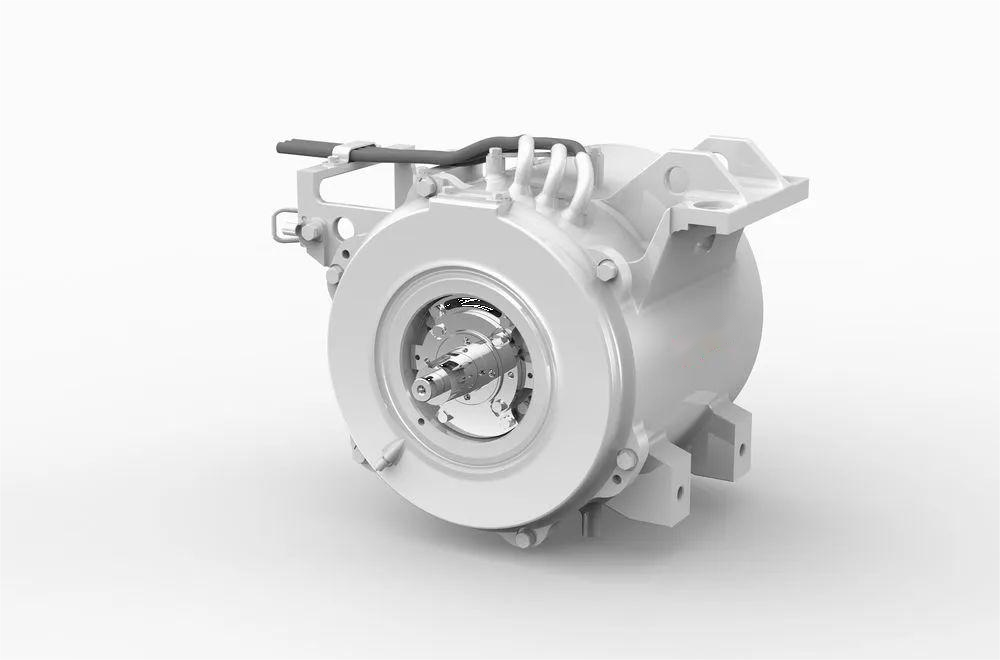The permanent magnet synchronous motor comprises mainly a stator, rotor, and end cover. The stator is made up of laminated sheets to reduce iron loss produced during the running of the motor. It carries a three-phase AC winding known as an armature. The rotor can be either made in solid or pressed from laminations to which permanent magnet material may be attached. According to the location of permanent magnet material on the rotor of the motor, a permanent magnet synchronous motor could be divided into two kinds of structural forms: projected type and built-in type.
The magnetic circuit structure is simple with low manufacturing cost in the protruding rotor. However, one limit is that the starting winding cannot be installed on the surface, and asynchronous starting cannot be realized. On the contrary, the magnetic circuit structures of the rotors built-in are more complicated and can be divided into three main types: radial, tangential, and hybrid. These types mainly differ in the relationship between the magnetization direction of a permanent magnet and the rotation direction of a rotor.
PMSMs are widely regarded as high-efficiency motors due to their superior power density, high efficiency, and reliability. Despite the many advantages of PMSMs, several issues can be faced during no-load operation: oscillation, noise, and power fluctuations. Different approaches can be employed to overcome these problems and optimize the performance of PMSMs.
The radial-type magnetic circuit structure has permanent magnets arranged radially, and the direction of magnetization is perpendicular to the rotation of the rotor. It can provide a strong magnetic field, which contributes to high torque output and efficiency.
In the magnetic circuit structure tangential-type, though, only the permanent magnets are arranged tangentially to the circle of rotor rotation. These will have an increasing effect on the magnetic field distribution, thus reducing any cogging torque in such a motor design to a minimum.
A hybrid type combines features of the radial and tangential configuration, whereby a compromise between several advantages of either is sought. Optimizing the magnetization direction by enhancing the magnetic circuit increases the performance and efficiency of the hybrid designs to also meet particular application requirements.
In practice, the solutions for no-load problems regarding PMSMs are provided in several ways:
Load Simulation Techniques: It would balance the no-load oscillations by simulating the load conditions and hence maintaining stability during no-load operation. This is quite useful in certain applications as one can maintain a consistent performance.
Adaptive Control Systems: Make changes when load conditions change rapidly to achieve optimal performances of the motor. Their real-time adjustment to fluctuating loads prevents pointless energy use and can also minimize damage due to its fluctuations.
Noise Reduction Measures: T he acoustic enclosure and balancing service of the rotor on a scheduled basis can greatly reduce noise. These measures are very important in an environment where noise levels need to be controlled to prevent disruption or in compliance with regulations.
Smoothing of Power Output Variations: A combination of energy storage devices, such as batteries and supercapacitors, with variable frequency drives creates the possibility of smooth power output operation. These technologies offer a constant power supply without any no-load conditions; they buffer fluctuations and manage motor speed according to the load.
By applying these approaches, the PMSM performance can be optimized and it can be ensured that PMSMs will be running effectively under a wide range of working conditions. It not only optimizes the motor performance but also prolongs its life cycle, minimizing the frequency of maintenance and increasing the feasibility for many industrial applications.

Enhancing System Stability for Real-World Applications
Load Simulation Techniques
Adaptive Control Systems
Noise Reduction Strategies Based on Field Experience
Acoustic Enclosures
Balancing Services
Mitigating Power Fluctuations with Proven Methods
Energy Storage Systems
Variable Frequency Drives (VFDs)
Customization for Specific Industry Needs
Industry-Specific Motor Designs
How it was useful: For meeting particular industrial requirements of different industries, customizing TYP Series motors makes them ensures their appropriate performance.
Example Application: In food industries where hygiene is very important, PMSMs can be designed with smooth surfaces and easy-to-clean materials: This design averts contamination and reduces maintenance during no-load operation, therefore keeping the standards of cleanliness and operational efficiency high.
Harmonic Mitigation
Impact on PMSM Performance
Future Prospects

v